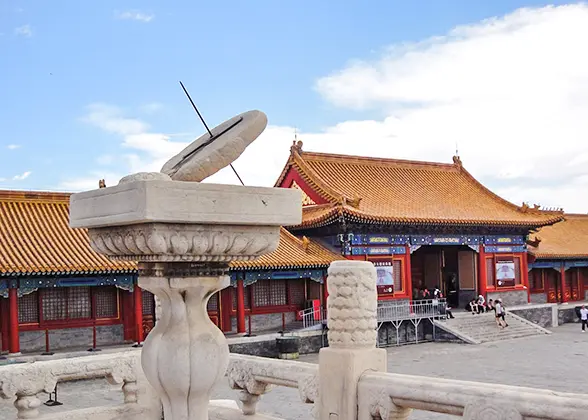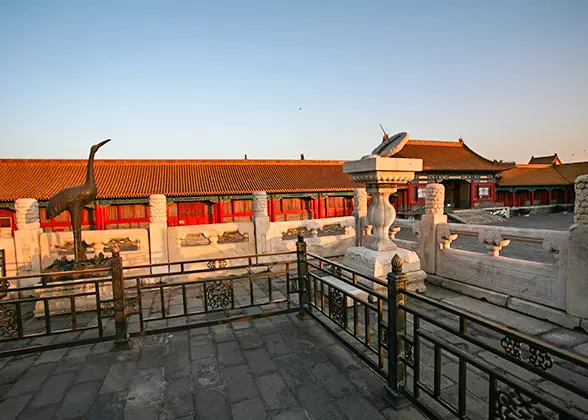Miraculous Sundials in the Forbidden City
The sundials in the Forbidden City can be found in front of the Hall of Supreme Harmony, Palace of Heavenly Purity, Hall of Spiritual Cultivation and Hall of Happiness and Longevity. They were used to tell the time of the day, solar terms and symbolize the emperor's supreme power to confer time on all the people over the country.
Each sundial consists of a round sundial plate, a gnomon and a base. The sundial plate is made of white marble with scales on both sides. Each scale represents an hour. The gnomon is made of iron and pierce vertically through the plate. The sundial base is square and supported by stone pillars.
The sundial plate is placed parallel to the equator on the base. In other words, the angle between the sundial plate and the vertical line of the ground is exactly the latitude of where the sundial is located. The Forbidden City is located at 39° 54 north latitude, so the angle is exactly 39° 54. That is to say that the sharp angle between the sundial plate and the ground is about 51° 06.
The gnomon points to the north and south poles and its shadow on the sundial plate moves with the sun, just like the hand of the clock. The whole plate is divided into 360 degrees, which is equivalent to 15 degrees per hour. The noon shadow is vertically downward.
On the two days of Spring Equinox and Autumn Equinox, the gnomon on both sides of sundial plate work. From the Spring Equinox to the Autumnal Equinox, the sun always moves on the north side of the celestial equator, and the shadow of the gnomon projects above the sundial plate; in the other half of the year, the sun moves on the south side of the celestial equator, and the shadow of the sundial needle projects below the sundial plate. So after the Spring Equinox, check the time at the top of the sundial plate while see the opposite part of the sundial plate after the Autumn Equinox.
Of course, disadvantages of sundials are also obvious. It can't be moved easily and used when it's cloudy, rainy, or dark without sunshine. In 1601, the Ming Dynasty Emperor Wanli got two foreign self-ringing clocks. Since then, more and more imported and self-made clocks and watches were used to replace the sundials in the Forbidden City.
Guibiao, an astronomical instrument for measuring the length of the sun's shadow, consists of two parts: Gui and Biao. The straight rod perpendicular to the ground is called Biao while the ruler placed horizontally on the ground with a scale to measure the length of the shadow is called Gui. Ancient Chinese knew the coming of different seasons by observing and recording the shadow length at noon. Guibiao can also tell 24 solar terms. When the shadow is the longest, the Winter Solstice is coming; when it is the shortest, the Summer Solstice is coming.
The Louke (Water Clock) consists of leaky pots and a ruler. The leaky pot discharges or holds water and the ruler is put it in the pot. When water flows out or into the pot, the ruler moves up and down. From the scale on the ruler, people can know the specific time. In the early stage, single leaky pot was used but the dripping speed is affected by the amount of water in the pot, causing lower time accuracy. To solve this problem, the ancients started to use several leaky pots to decrease the water quantity at each pot. Hence, the time accuracy was increased.
Xiangzhuan Bell was popular in the middle of the 12th century. Xiangzhuan Bell is a plum shaped brass plate with five plum petals. Each plum petal is wrapped with a circle of incense. Ancients told the time based on the burning degree of the incense.
Each sundial consists of a round sundial plate, a gnomon and a base. The sundial plate is made of white marble with scales on both sides. Each scale represents an hour. The gnomon is made of iron and pierce vertically through the plate. The sundial base is square and supported by stone pillars.
How does the sundial tell the time of the day?
The sundial plate is placed parallel to the equator on the base. In other words, the angle between the sundial plate and the vertical line of the ground is exactly the latitude of where the sundial is located. The Forbidden City is located at 39° 54 north latitude, so the angle is exactly 39° 54. That is to say that the sharp angle between the sundial plate and the ground is about 51° 06.
The gnomon points to the north and south poles and its shadow on the sundial plate moves with the sun, just like the hand of the clock. The whole plate is divided into 360 degrees, which is equivalent to 15 degrees per hour. The noon shadow is vertically downward.
|
|
How does the sundial tell the solar terms?
Of course, disadvantages of sundials are also obvious. It can't be moved easily and used when it's cloudy, rainy, or dark without sunshine. In 1601, the Ming Dynasty Emperor Wanli got two foreign self-ringing clocks. Since then, more and more imported and self-made clocks and watches were used to replace the sundials in the Forbidden City.
Other Famous Time-meters in Ancient China
Guibiao
Guibiao, an astronomical instrument for measuring the length of the sun's shadow, consists of two parts: Gui and Biao. The straight rod perpendicular to the ground is called Biao while the ruler placed horizontally on the ground with a scale to measure the length of the shadow is called Gui. Ancient Chinese knew the coming of different seasons by observing and recording the shadow length at noon. Guibiao can also tell 24 solar terms. When the shadow is the longest, the Winter Solstice is coming; when it is the shortest, the Summer Solstice is coming.
Louke (Water Clock)
The Louke (Water Clock) consists of leaky pots and a ruler. The leaky pot discharges or holds water and the ruler is put it in the pot. When water flows out or into the pot, the ruler moves up and down. From the scale on the ruler, people can know the specific time. In the early stage, single leaky pot was used but the dripping speed is affected by the amount of water in the pot, causing lower time accuracy. To solve this problem, the ancients started to use several leaky pots to decrease the water quantity at each pot. Hence, the time accuracy was increased.
Xiangzhuan Bell (Incense Bell)
Xiangzhuan Bell was popular in the middle of the 12th century. Xiangzhuan Bell is a plum shaped brass plate with five plum petals. Each plum petal is wrapped with a circle of incense. Ancients told the time based on the burning degree of the incense.
- Last updated on Aug. 01, 2025 by Gabby Li -

